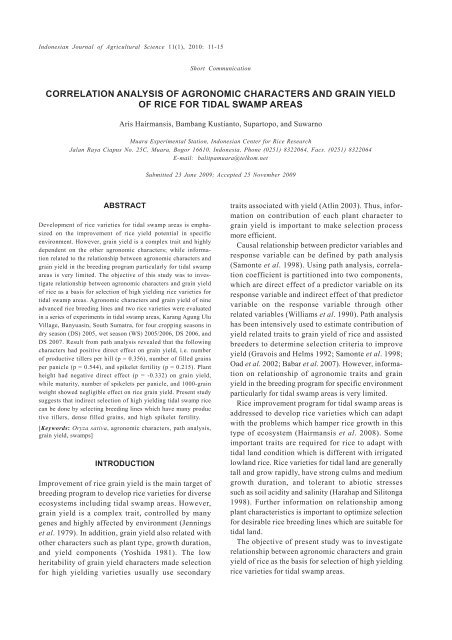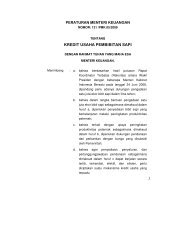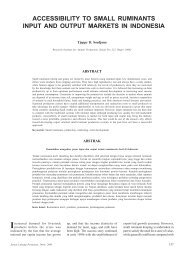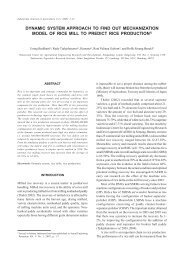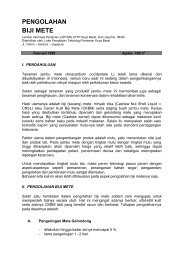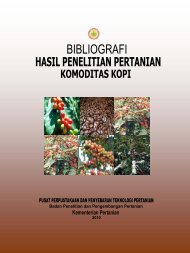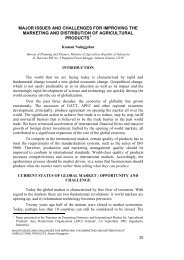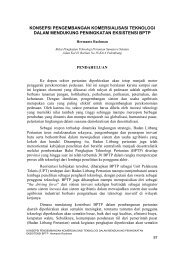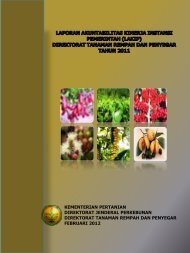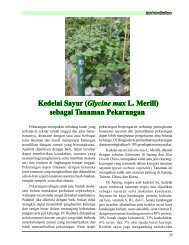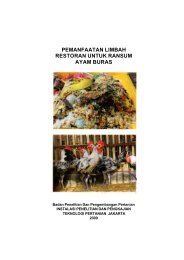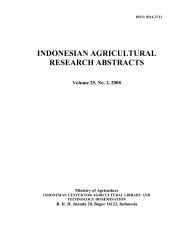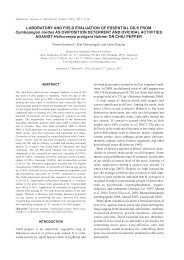correlation analysis of agronomic characters and ... - Pustaka Deptan
correlation analysis of agronomic characters and ... - Pustaka Deptan
correlation analysis of agronomic characters and ... - Pustaka Deptan
- No tags were found...
Create successful ePaper yourself
Turn your PDF publications into a flip-book with our unique Google optimized e-Paper software.
Correlation Indonesian <strong>analysis</strong> Journal <strong>of</strong> <strong>of</strong> <strong>agronomic</strong> Agricultural <strong>characters</strong> Science <strong>and</strong> 11(1), grain 2010: yield <strong>of</strong> 11-15 rice ... 11Short CommunicationCORRELATION ANALYSIS OF AGRONOMIC CHARACTERS AND GRAIN YIELDOF RICE FOR TIDAL SWAMP AREASAris Hairmansis, Bambang Kustianto, Supartopo, <strong>and</strong> SuwarnoMuara Experimental Station, Indonesian Center for Rice ResearchJalan Raya Ciapus No. 25C, Muara, Bogor 16610, Indonesia, Phone (0251) 8322064, Facs. (0251) 8322064E-mail: balitpamuara@telkom.netSubmitted 23 June 2009; Accepted 25 November 2009ABSTRACTDevelopment <strong>of</strong> rice varieties for tidal swamp areas is emphasizedon the improvement <strong>of</strong> rice yield potential in specificenvironment. However, grain yield is a complex trait <strong>and</strong> highlydependent on the other <strong>agronomic</strong> <strong>characters</strong>; while informationrelated to the relationship between <strong>agronomic</strong> <strong>characters</strong> <strong>and</strong>grain yield in the breeding program particularly for tidal swampareas is very limited. The objective <strong>of</strong> this study was to investigaterelationship between <strong>agronomic</strong> <strong>characters</strong> <strong>and</strong> grain yield<strong>of</strong> rice as a basis for selection <strong>of</strong> high yielding rice varieties fortidal swamp areas. Agronomic <strong>characters</strong> <strong>and</strong> grain yield <strong>of</strong> nineadvanced rice breeding lines <strong>and</strong> two rice varieties were evaluatedin a series <strong>of</strong> experiments in tidal swamp areas, Karang Agung UluVillage, Banyuasin, South Sumatra, for four cropping seasons indry season (DS) 2005, wet season (WS) 2005/2006, DS 2006, <strong>and</strong>DS 2007. Result from path <strong>analysis</strong> revealed that the following<strong>characters</strong> had positive direct effect on grain yield, i.e. number<strong>of</strong> productive tillers per hill (p = 0.356), number <strong>of</strong> filled grainsper panicle (p = 0.544), <strong>and</strong> spikelet fertility (p = 0.215). Plantheight had negative direct effect (p = -0.332) on grain yield,while maturity, number <strong>of</strong> spikelets per panicle, <strong>and</strong> 1000-grainweight showed negligible effect on rice grain yield. Present studysuggests that indirect selection <strong>of</strong> high yielding tidal swamp ricecan be done by selecting breeding lines which have many productive tillers, dense filled grains, <strong>and</strong> high spikelet fertility.[Keywords: Oryza sativa, <strong>agronomic</strong> <strong>characters</strong>, path <strong>analysis</strong>,grain yield, swamps]INTRODUCTIONImprovement <strong>of</strong> rice grain yield is the main target <strong>of</strong>breeding program to develop rice varieties for diverseecosystems including tidal swamp areas. However,grain yield is a complex trait, controlled by manygenes <strong>and</strong> highly affected by environment (Jenningset al. 1979). In addition, grain yield also related withother <strong>characters</strong> such as plant type, growth duration,<strong>and</strong> yield components (Yoshida 1981). The lowheritability <strong>of</strong> grain yield <strong>characters</strong> made selectionfor high yielding varieties usually use secondarytraits associated with yield (Atlin 2003). Thus, informationon contribution <strong>of</strong> each plant character tograin yield is important to make selection processmore efficient.Causal relationship between predictor variables <strong>and</strong>response variable can be defined by path <strong>analysis</strong>(Samonte et al. 1998). Using path <strong>analysis</strong>, <strong>correlation</strong>coefficient is partitioned into two components,which are direct effect <strong>of</strong> a predictor variable on itsresponse variable <strong>and</strong> indirect effect <strong>of</strong> that predictorvariable on the response variable through otherrelated variables (Williams et al. 1990). Path <strong>analysis</strong>has been intensively used to estimate contribution <strong>of</strong>yield related traits to grain yield <strong>of</strong> rice <strong>and</strong> assistedbreeders to determine selection criteria to improveyield (Gravois <strong>and</strong> Helms 1992; Samonte et al. 1998;Oad et al. 2002; Babar et al. 2007). However, informationon relationship <strong>of</strong> <strong>agronomic</strong> traits <strong>and</strong> grainyield in the breeding program for specific environmentparticularly for tidal swamp areas is very limited.Rice improvement program for tidal swamp areas isaddressed to develop rice varieties which can adaptwith the problems which hamper rice growth in thistype <strong>of</strong> ecosystem (Hairmansis et al. 2008). Someimportant traits are required for rice to adapt withtidal l<strong>and</strong> condition which is different with irrigatedlowl<strong>and</strong> rice. Rice varieties for tidal l<strong>and</strong> are generallytall <strong>and</strong> grow rapidly, have strong culms <strong>and</strong> mediumgrowth duration, <strong>and</strong> tolerant to abiotic stressessuch as soil acidity <strong>and</strong> salinity (Harahap <strong>and</strong> Silitonga1998). Further information on relationship amongplant characteristics is important to optimize selectionfor desirable rice breeding lines which are suitable fortidal l<strong>and</strong>.The objective <strong>of</strong> present study was to investigaterelationship between <strong>agronomic</strong> <strong>characters</strong> <strong>and</strong> grainyield <strong>of</strong> rice as the basis for selection <strong>of</strong> high yieldingrice varieties for tidal swamp areas.
12 Aris Hairmansis et al.MATERIALS AND METHODSThe rice breeding lines <strong>and</strong> varieties used in thisstudy are shown in Table 1. The materials consisted<strong>of</strong> nine advanced breeding lines <strong>and</strong> two improvedrice varieties for tidal swamp areas, IR42 <strong>and</strong>Batanghari. These breeding lines have been selectedfor several generations in tidal swamp areas <strong>and</strong>derived from different crosses. Most <strong>of</strong> the rice lineswere developed by the Indonesian Center for RiceResearch in Sukam<strong>and</strong>i, West Java. Two breeding lines,KAL9414F-MR-2-KN-0 <strong>and</strong> KAL9418F-MR-2-KN-0,were developed by the Indonesian Swampl<strong>and</strong> AgriculturalResearch Institute in Banjarbaru, South Kalimantan.The IR61242-3B-B-2 line was introduced fromthe International Rice Research Institute, Philippines.The experiments were carried out in Karang AgungUlu village, Banyuasin district, South Sumatra, duringfour seasons which were dry season (DS) 2005, wetseason (WS) 2005/2006, DS 2006, <strong>and</strong> DS 2007. Thissite was characterized as potential acid sulphate area.The soil type was alluvial with soil pH <strong>of</strong> 4.5. Thetrials were arranged in a r<strong>and</strong>omized complete blockdesign with four replications. Each line was grown inTable 1. Rice breeding lines <strong>and</strong> varieties used in the study.Lines/varietiesB9833C-KA-14B9852E-KA-66B5244G-SM-61-2-1B7003D-MR-24-3-1B9858D-KA-55B10214F-TB-7-2-3KAL9414F-MR-2-KN-0KAL9418F-MR-2-KN-0IR61242-3B-B-2IR42BatanghariParentageIR52///Batang Agam/IR54742//BatangOmbilin/IR68Batang Ombilin/IR9884-54-3IR13168-143-1/LMN III//IR13292-5-3Kapuas3/IR56Batang Ombilin/DukuhPucuk/Cisanggarung//SitaSiam Unus/CisokanRantai/CisokanIR42253-63-1-2-3/BW100Released varietyReleased varietya 4 m x 5 m plot. The 21-day-old seedlings from wet-bednurseries were transplanted at three seedlings per hillat a spacing <strong>of</strong> 25 cm x 25 cm. Each plot was fertilizedwith urea 200 kg, SP36 100 kg, <strong>and</strong> KCl 100 kg ha -1 .Data were collected for plant height (cm), number<strong>of</strong> productive tillers per hill, maturity (day), number <strong>of</strong>filled grains per panicle, number <strong>of</strong> spikelets perpanicle, spikelet fertility per panicle (%), 1000-grainweight (g), <strong>and</strong> grain yield (t ha -1 ). Measurement <strong>of</strong>rice <strong>characters</strong> referred to st<strong>and</strong>ard evaluation systemfor rice (IRRI 1996).Relationships between <strong>agronomic</strong> <strong>characters</strong> <strong>and</strong>grain yield were analyzed using simple <strong>correlation</strong><strong>analysis</strong> <strong>and</strong> path <strong>analysis</strong> (Singh <strong>and</strong> Chaundhary1979). Analysis was taken based on average data ineach environment. Simple <strong>correlation</strong> <strong>and</strong> path <strong>analysis</strong>were computed using computer s<strong>of</strong>tware package<strong>of</strong> SAS version 8.RESULTS AND DISCUSSIONCoefficients <strong>of</strong> <strong>correlation</strong> between all pairs <strong>of</strong> tidalswamp rice <strong>characters</strong> are shown in Table 2. The<strong>agronomic</strong> <strong>characters</strong> which had positive relationshipwith grain yield were number <strong>of</strong> filled grains perpanicle (r = 0.677), number <strong>of</strong> spikelets per panicle (r =0.217), <strong>and</strong> spikelet fertility per panicle (r = 0.445). Onthe contrary, plant height (r = -0.258) was inverselycorrelated with grain yield. Among these traits, filledgrains <strong>and</strong> spikelet fertility were significantly correlatedwith grain yield. The other <strong>characters</strong>, number <strong>of</strong>productive tillers (r = 0.056) <strong>and</strong> 1000-grain weight (r =-0.020), showed very weak <strong>correlation</strong> with grainyield. Gravois <strong>and</strong> Helms (1992) reported the importance<strong>of</strong> number <strong>of</strong> filled grains per panicle in determination<strong>of</strong> rice yield. In addition, Silitonga (1989)observed significant positive <strong>correlation</strong> betweennumber <strong>of</strong> filled grains <strong>and</strong> grain yield <strong>of</strong> hybrid riceTable 2. Simple <strong>correlation</strong> between all pairs <strong>of</strong> tidal swamp rice <strong>characters</strong>.CharactersNo. <strong>of</strong> No. <strong>of</strong> No. <strong>of</strong> Spikelet1000-grain Grainproductive Maturity filled grains spikelets fertilityweight yieldtillers per hill per panicle per panicle per paniclePlant height 0.570** -0.251 -0.131 -0.219 0.098 -0.687** -0.258No. <strong>of</strong> productive tillers per hill -0.219 -0.120 -0.241 0.147 -0.637** 0.056Maturity 0.019 0.318* -0.302* -0.065 -0.020No. <strong>of</strong> filled grains per panicle 0.478** 0.493** -0.140 0.677**No. <strong>of</strong> spikelets per panicle -0.526** 0.000 0.217Spikelet fertility per panicle -0.148 0.445**1000-grain weight -0.020* <strong>and</strong> ** = significantly different at P < 0.05 <strong>and</strong> P < 0.01, respectively.
Correlation <strong>analysis</strong> <strong>of</strong> <strong>agronomic</strong> <strong>characters</strong> <strong>and</strong> grain yield <strong>of</strong> rice ... 13<strong>and</strong> suggested to use this trait in selecting highyielding hybrid rice.Correlation coefficients between <strong>agronomic</strong> <strong>characters</strong><strong>of</strong> tidal swamp rice as predictor variables <strong>and</strong>grain yield as response variable were partitioned intodirect effect (p) <strong>and</strong> indirect effect (rp) through path<strong>analysis</strong>. Path coefficient <strong>of</strong> <strong>agronomic</strong> traits ongrain yield <strong>of</strong> tidal swamp rice is shown in Table 3.Plant height had negative direct effect (p = -0.332)on grain yield. Its indirect effects on grain yieldthrough maturity, number <strong>of</strong> filled grains per panicle,number <strong>of</strong> spikelets per panicle, <strong>and</strong> 1000-grainweight were negative, but it had positive indirecteffect via number <strong>of</strong> productive tillers per hill. Product<strong>of</strong> these direct <strong>and</strong> indirect effects made this <strong>characters</strong>negatively correlated (r = -0.258) with grainyield. Number <strong>of</strong> productive tillers had positive <strong>and</strong>moderate direct effect (p = 0.356) on grain yield,however its indirect effect through other <strong>characters</strong>was mostly negative. This character only had positiveindirect effect through spikelet fertility per panicle (rp= 0.032). When positive direct effect <strong>of</strong> number <strong>of</strong>productive tillers added with its indirect effectthrough other <strong>agronomic</strong> traits, the sum (<strong>correlation</strong>between number <strong>of</strong> productive tillers <strong>and</strong> grain yield)was very low (r = 0.056). Previous papers alsomentioned that number <strong>of</strong> tillers had positive directeffect on grain yield (Samonte et al. 1998; Oad et al.2002). On the other h<strong>and</strong>, the low <strong>correlation</strong> betweenmaturity <strong>and</strong> grain yield was figured by its low direct<strong>and</strong> indirect effects through other yield related traits.Its negative indirect effects through number <strong>of</strong>productive tillers, spikelet fertility, <strong>and</strong> 1000-grainweight resulted in negative <strong>correlation</strong> betweenmaturity <strong>and</strong> grain yield.Number <strong>of</strong> filled grains per panicle showed thehighest <strong>correlation</strong> (r = 0.677) with grain yield comparedto the other <strong>characters</strong>. This strong relationshipwas mostly determined by its direct effect on grainyield (p = 0.544). Its low indirect effects through othertraits indicated that direct selection using this trait toselect high yielding breeding lines will be effective.This result coincided with the previous studies whichalso reported that number <strong>of</strong> filled grains per paniclehad significant positive direct effect on rice grainyield (Gravois <strong>and</strong> Helms 1992; Samonte et al. 1998).On the contrary, number <strong>of</strong> spikelets per panicleexhibited very weak direct effect (p = 0.080) on grainyield, even though its <strong>correlation</strong> coefficient withnumber <strong>of</strong> filled grains per panicle was significantlypositive.Another character that positively correlated withgrain yield was spikelet fertility (r = 0.445). PartitioningTable 3. Path coefficients <strong>of</strong> <strong>agronomic</strong> <strong>characters</strong> on grainyield <strong>of</strong> tidal swamp rice.Correlationr valuePlant height vs grain yield -0.258Direct effect -0.332Indirect effect via:No. <strong>of</strong> productive tillers per hill 0.203Maturity -0.002No. <strong>of</strong> filled grains per panicle -0.071No. <strong>of</strong> spikelets per panicle -0.017Spikelet fertility per panicle 0.0211000-grain weight -0.060No. <strong>of</strong> productive tillers vs grain yield 0.056Direct effect 0.356Indirect effect via:Plant height -0.189Maturity -0.002No. <strong>of</strong> filled grains per panicle -0.066No. <strong>of</strong> spikelets per panicle -0.019Spikelet fertility per panicle 0.0321000-grain weight -0.055Maturity vs grain yield -0.020Direct effect 0.009Indirect effect via:Plant height 0.083No. <strong>of</strong> productive tillers per hill -0.078No. <strong>of</strong> filled grains per panicle 0.010No. <strong>of</strong> spikelets per panicle 0.025Spikelet fertility per panicle -0.0651000-grain weight -0.006No. <strong>of</strong> filled grains vs grain yield 0.677Direct effect 0.544Indirect effect via:Plant height 0.044No. <strong>of</strong> productive tillers per hill -0.043Maturity 0.000No. <strong>of</strong> spikelets per panicle 0.038Spikelet fertility per panicle 0.1061000-grain weight -0.012No. <strong>of</strong> spikelets vs grain yield 0.217Direct effect 0.080Indirect effect via:Plant height 0.073No. <strong>of</strong> productive tillers per hill -0.086Maturity 0.003No. <strong>of</strong> filled grains per panicle 0.260Spikelet fertility per panicle -0.1131000-grain weight 0.000Spikelet fertility vs grain yield 0.445Direct effect 0.215Indirect effect via:Plant height -0.033No. <strong>of</strong> productive tillers per hill 0.052Maturity -0.003No. <strong>of</strong> filled grains per panicle 0.268No. <strong>of</strong> spikelets per panicle -0.0421000-grain weight -0.0131000-grain weight vs grain yield -0.020Direct effect 0.087
14 Aris Hairmansis et al.Table 3. (continued).Correlationr valueIndirect effect via:Plant height 0.228No. <strong>of</strong> productive tillers per hill -0.227Maturity -0.001No. <strong>of</strong> filled grains per panicle -0.076No. <strong>of</strong> spikelets per panicle 0.000Spikelet fertility -0.032Residual effect 0.644this coefficient <strong>correlation</strong> showed that the relationshipwas mostly determined by its positive directeffect (p = 0.215) on grain yield <strong>and</strong> its positiveindirect effect through number <strong>of</strong> filled grains (rp =0.268). Furthermore, loose association between 1000-grain weight <strong>and</strong> grain yield was caused by its lowdirect effect <strong>and</strong> indirect effect coefficients. Yoshida(1981) described that the components <strong>of</strong> rice grainyield consisted <strong>of</strong> number <strong>of</strong> spikelets, percentage <strong>of</strong>filled spikelets, <strong>and</strong> 1000-grain weight; <strong>and</strong> amongthose, number <strong>of</strong> spikelets was the most importantcomponent limiting rice yield, while 1000-grain weightwas rarely affected grain yield.Figure 1 explains detailed pathway <strong>of</strong> <strong>agronomic</strong>character effects on grain yield <strong>and</strong> its relationship <strong>of</strong>each other in determination <strong>of</strong> rice yield. Positive pathcoefficients <strong>of</strong> number <strong>of</strong> filled grains per panicle,number <strong>of</strong> productive tillers <strong>and</strong> spikelet fertilityindicated the importance <strong>of</strong> these <strong>characters</strong> as asecondary trait in the selection to increase grain yield.In addition, plant height character which had negativedirect effect on grain yield should be considered inthe selection process by selecting rice plant type withsemi-dwarf or intermediate plant height. Even thoughtidal swamp rice varieties are generally taller thanirrigated rice, result from the present study indicatedthe importance <strong>of</strong> selection to reduce plant height toincrease rice yield in tidal swamp areas. Yoshida(1981) suggested that high yield gain in rice varietieswith reduced plant height associated with increase inlodging resistance <strong>of</strong> rice plant.Knowledge on contribution <strong>of</strong> each <strong>agronomic</strong>character to grain yield will be useful to assist ricePlant height (1)r 12= 0.570p = -0.332No. <strong>of</strong> productive tillers (2)r 17= -0.687r 16= 0.098r 15= -0.219r 14= -0.131r 13= -0.251p = 0.356r 23= -0.219Maturity (3)p = 0.009r 34= 0.019r 24= -0.120r 25= -0.241r 26= 0.147r 27= -0.637Grainyieldp = 0.544 No. <strong>of</strong> filled grains per panicle (4)r 45= 0.478r 35= 0.318r 36= -0.302r 37= -0.065p = 0.080No. <strong>of</strong> spikelets per panicle (5)r 56= -0.526r 46= 0.493r 47= -0.140Residualeffect = 0.644p = 0.215Spikelet fertility (6)r 67= -0.148r 57= -0.000p = 0.0871000-grain weight (7)Fig. 1. Path diagram <strong>of</strong> tidal swamp rice <strong>agronomic</strong> <strong>characters</strong>. Single headed arrow lines indicate path coefficient <strong>of</strong><strong>agronomic</strong> <strong>characters</strong> on grain yield, double headed arrow lines indicate <strong>correlation</strong> coefficient between all pairs <strong>of</strong><strong>agronomic</strong> <strong>characters</strong>.
Correlation <strong>analysis</strong> <strong>of</strong> <strong>agronomic</strong> <strong>characters</strong> <strong>and</strong> grain yield <strong>of</strong> rice ... 15breeders as the indirect selection <strong>of</strong> grain yield duringthe early generation before conducting replicatedyield trials (Samonte et al. 1998). However, this studyalso showed high residual effect coefficient that was0.644, which indicated there were other variableswhich determined rice grain yield <strong>and</strong> were not yetexplained in this experiment. Further studies areneeded to elucidate relationship <strong>of</strong> grain yield <strong>and</strong>the other morpho-physiological traits which is relatedto soil stress tolerance in tidal swamp areas such soilacidity, iron toxicity, aluminum toxicity, <strong>and</strong> nutrientdeficiency.CONCLUSIONPartitioning <strong>correlation</strong> coefficient through path<strong>analysis</strong> clarified direct effect <strong>of</strong> each <strong>agronomic</strong> characteron grain yield <strong>of</strong> tidal swamp rice. Characterswith positive direct effects on grain yield includednumber <strong>of</strong> productive tillers per hill, number <strong>of</strong> filledgrains per panicle, <strong>and</strong> spikelet fertility. Plant heighthad negative direct effect on grain yield, whilematurity, number <strong>of</strong> spikelets per panicle, <strong>and</strong> 1000-grain weight showed a weak direct effect on rice grainyield. Based on this information, indirect selection <strong>of</strong>high yielding tidal swamp rice can be taken byselecting breeding lines which have many productivetillers, dense filled grains, <strong>and</strong> high spikelet fertility.ACKNOWLEDGEMENTThis study was supported by funding from theIndonesian Center for Rice Research, the IndonesianAgency for Agricultural Research <strong>and</strong> Development.REFERENCESAtlin, G. 2003. Improving drought tolerance by selecting foryield. p. 14-22. In K.S. Fischer, R. Lafitte, S. Fukai, G. Atlin,<strong>and</strong> B. Hardy (Eds.). Breeding Rice for Drought-ProneEnvironments. IRRI, Los Banos, the Philippines.Babar, M., A.A. Khan, A. Arif, Y. Zafar, dan M. Arif. 2007. Path<strong>analysis</strong> <strong>of</strong> some leaf <strong>and</strong> panicle traits affecting grain yield indoubled haploid lines <strong>of</strong> rice (Oryza sativa L.). J. Agric. Res.45(4): 245-252.Gravois, K.A. <strong>and</strong> R.S. Helms. 1992. Path <strong>analysis</strong> <strong>of</strong> rice yield <strong>and</strong>yield components as affected by seeding rate. Agron. J. 84: 1-4.Hairmansis, A., B. Kustianto, Supartopo, dan Suwarno. 2008.Pemuliaan padi rawa pasang surut dan lebak. hlm. 319-328.Dalam A.K. Makarim, B. Suprihatno, Z. Zaini, A. Widjono,I.N. Widiarta, Hermanto, dan H. Kasim (Ed.). Inovasi TeknologiTanaman Pangan, Buku 2. Penelitian dan Pengembangan Padi.Pusat Penelitian dan Pengembangan Tanaman Pangan, Bogor,Indonesia.Harahap, Z. dan T.S. Silitonga. 1998. Perbaikan varietas padi.hlm. 335-361. Dalam M. Ismunadji, M. Syam, dan Yuswadi(Ed.). Padi, Buku 2. Pusat Penelitian dan PengembanganTanaman Pangan, Bogor, Indonesia.IRRI. 1996. St<strong>and</strong>ard Evaluation System for Rice (SES). IRRI,Los Banos, the Philippines.Jennings, P.R., W.R. C<strong>of</strong>fman, <strong>and</strong> H.E. Kaufman. 1979. RiceImprovement. IRRI, Los Banos, the Philippines. 186 pp.Oad, F.C., M.A. Samo, Z.U. Hassan, P.S. Cruz, <strong>and</strong> N.L. Oad.2002. Correlation <strong>and</strong> path <strong>analysis</strong> <strong>of</strong> quantitative <strong>characters</strong><strong>of</strong> rice ratoon cultivars <strong>and</strong> advance lines. Int. J. Agric. Biol.4(2): 204-207.Samonte, S.O.P.B., L.T. Wilson, <strong>and</strong> A.M. McClung. 1998. Pathanalyses <strong>of</strong> yield <strong>and</strong> yield-related traits <strong>of</strong> fifteen diverse ricegenotypes. Crop Sci. 38: 1130-1136.Silitonga, T.S. 1989. Analisis koefisien lintasan dari komponenhasil galur-galur padi hibrida. Penelitian Pertanian 9(2): 68-70.Singh, R.K. <strong>and</strong> B.D. Chaundhary. 1979. Biometrical Method inQuantitative Genetic Analysis. Kalyani Publishers, New Delhi,India. 304 pp.Williams, W.A., M.B. Jones, <strong>and</strong> M.W. Demment. 1990. A concisetable for path <strong>analysis</strong> statistics. Agron. J. 82: 1022-1024.Yoshida, S. 1981. Fundamentals <strong>of</strong> Rice Crop Science. IRRI, LosBanos, the Philippines. 269 pp.


